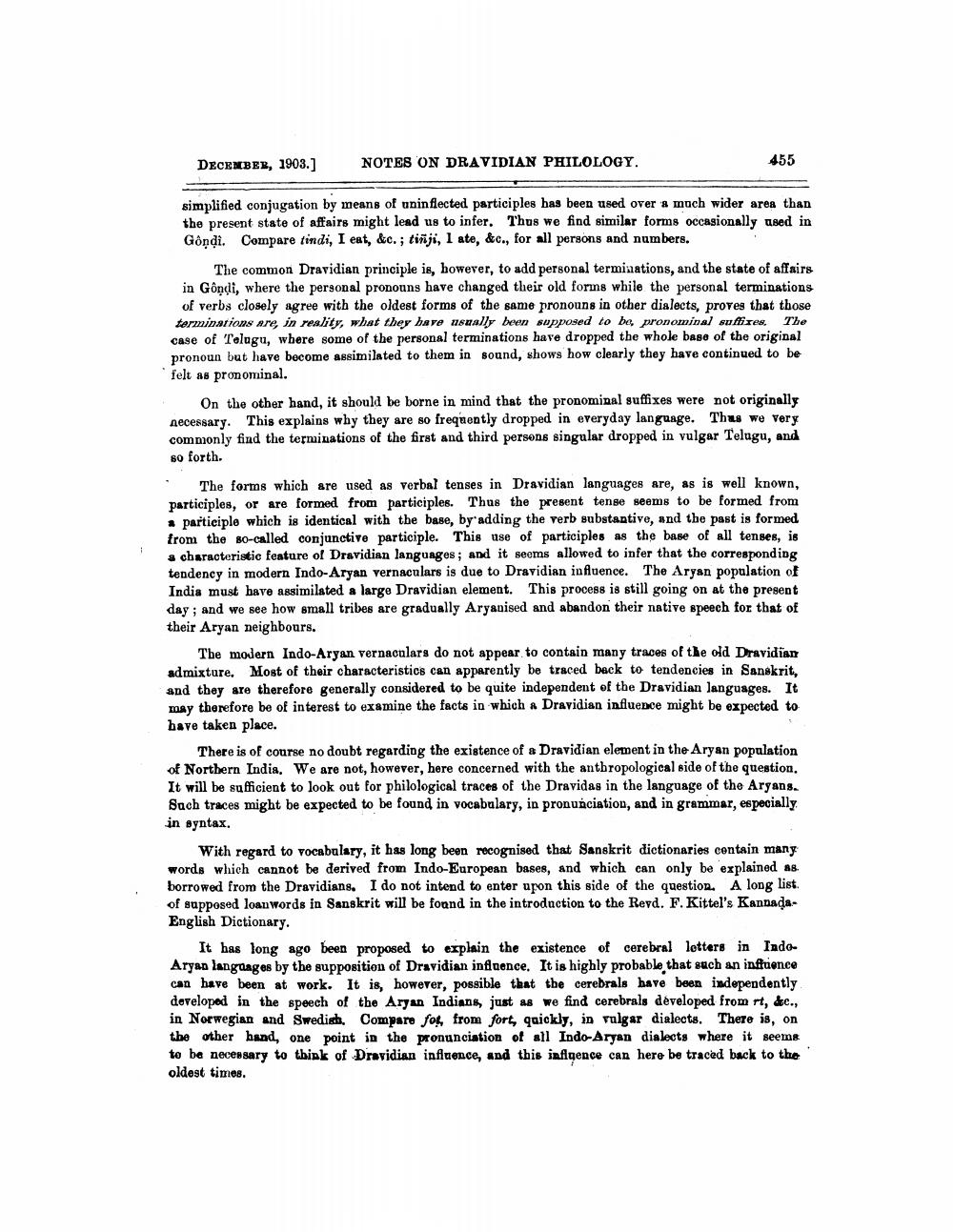________________
NOTES ON DRAVIDIAN PHILOLOGY.
455
DECEMBER, 1903.]
simplified conjugation by means of uninflected participles has been used over a much wider area than the present state of affairs might lead us to infer. Thus we find similar forms occasionally used in Gôndi. Compare tindi, I eat, &c.; tinji, I ate, &c., for all persons and numbers.
The
The common Dravidian principle is, however, to add personal terminations, and the state of affairs in Gôndi, where the personal pronouns have changed their old forms while the personal terminations of verbs closely agree with the oldest forms of the same pronouns in other dialects, proves that those terminations are, in reality, what they have usually been supposed to be, pronominal suffixes. case of Telugu, where some of the personal terminations have dropped the whole base of the original pronoun but have become assimilated to them in sound, shows how clearly they have continued to be felt as pronominal.
On the other hand, it should be borne in mind that the pronominal suffixes were not originally necessary. This explains why they are so frequently dropped in everyday language. Thus we very commonly find the terminations of the first and third persons singular dropped in vulgar Telugu, and so forth.
The forms which are used as verbal tenses in Dravidian languages are, as is well known, participles, or are formed from participles. Thus the present tense seems to be formed from a participle which is identical with the base, by adding the verb substantive, and the past is formed from the so-called conjunctive participle. This use of participles as the base of all tenses, is a characteristic feature of Dravidian languages; and it seems allowed to infer that the corresponding tendency in modern Indo-Aryan vernaculars is due to Dravidian influence. The Aryan population of India must have assimilated a large Dravidian element. This process is still going on at the present day; and we see how small tribes are gradually Aryanised and abandon their native speech for that of their Aryan neighbours.
The modern Indo-Aryan vernaculars do not appear to contain many traces of the old Dravidian admixture. Most of their characteristics can apparently be traced back to tendencies in Sanskrit, and they are therefore generally considered to be quite independent of the Dravidian languages. It may therefore be of interest to examine the facts in which a Dravidian influence might be expected to have taken place.
There is of course no doubt regarding the existence of a Dravidian element in the Aryan population of Northern India. We are not, however, here concerned with the anthropological side of the question. It will be sufficient to look out for philological traces of the Dravidas in the language of the Aryans. Such traces might be expected to be found in vocabulary, in pronunciation, and in grammar, especially in syntax.
With regard to vocabulary, it has long been recognised that Sanskrit dictionaries contain many words which cannot be derived from Indo-European bases, and which can only be explained as borrowed from the Dravidians. I do not intend to enter upon this side of the question. A long list. of supposed loanwords in Sanskrit will be found in the introduction to the Revd. F. Kittel's KannadaEnglish Dictionary.
It has long ago been proposed to explain the existence of cerebral letters in IndoAryan languages by the supposition of Dravidian influence. It is highly probable that such an influence can have been at work. It is, however, possible that the cerebrals have been independently developed in the speech of the Aryan Indians, just as we find cerebrals developed from rt, &c., in Norwegian and Swedish. Compare fot, from fort, quickly, in vulgar dialects. There is, on the other hand, one point in the pronunciation of all Indo-Aryan dialects where it seems to be necessary to think of Dravidian influence, and this influence can here be traced back to the oldest times.




